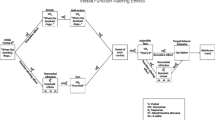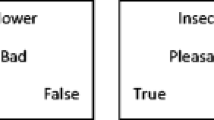Abstract
Although the verbal operants that comprise Skinner’s account of verbal behavior provide a seemingly complete description of the behavior of the speaker with respect to what is ordinarily called the expression of meanings, it may be shown that the account is intrinsically deficient in describing the receptive behavior of listeners with regard to their comprehension of the meanings of novel words, sentences and propositions. In response to this perceived deficiency, the notion of joint control is presented here. Joint control occurs when a verbal-operant topography, currently evoked by one stimulus, is additionally (i.e., jointly) evoked by a second stimulus. This event of joint stimulus control then sets the occasion for a response. This simple mechanism is shown here to have exceedingly broad explanatory properties: providing a coherent and rigorously behavioral account of various aspects of language ranging from meaning, reference and comprehension, to the development of abstraction in children’s speech.
Similar content being viewed by others
References
Benedict, H. (1979). Early lexical development: comprehension and production. Journal of Child Language, 6, 183–200.
Fodor, J. A., Bever, T. G. & Garrett, M. F. (1974). The Psychology of Language. New York: McGraw Hill.
Gamer, W.R. (1962). Uncertainty and structure as psychological constructs. New York: John Wiley & Sons.
Home, P. J., & Lowe, C. F. (1996). On the origins of naming and other symbolic behavior. Journal of the Experimental Analysis of Behavior, 65, 185–241.
Hull, C. L. (1943). Principles of behavior. New York: Appleton-Century-Crofts.
Kendler, H., & Kendler, T. (1962). Vertical and horizontal processes in problem solving. Psychological Review, 69, 1–16.
Lowenkron, B. (1984). Coding responses and the generalization of matching-to-sample in children. Journal ofthe Experimental Analysis of Behavior, 42, 1–18.
Lowenkron, B. (1988). Generalization of delayed identity matching in retarded children. Journal of the Experimental Analysis of Behavior, 50, 163–172.
Lowenkron, B. (1989). Instructional control of generalized relational matching to sample in children. Journal of the Experimental Analysis of Behavior, 52, 293–309.
Lowenkron, B. (1991). Joint control and the generalization of selection-based verbal behavior. The Analysis of Verbal Behavior, 9, 121–126.
Lowenkron, B. (1996). Joint control and word- object bidirectionality. Journal of the Experimental Analysis of Behavior, 65, 252–255.
Lowenkron, B. (1997). The role of naming in the development of joint control. Journal of the Experimental Analysis of Behavior, 68, 244–247.
Lowenkron, B. (1998). Some logical function of joint control. Journal of the Experimental Analysis of Behavior, 69, 327–354
Lowenkron, B. & Colvin, V. (1992). Joint control and generalized nonidentity matching: Saying when something is not. The Analysis of Verbal Behavior, 10, 1–10.
Lowenkron, B. & Colvin, V. (1995). Generalized instructional control and the production of broadly applicable relation responding. The Analysis of Verbal Behavior, 12, 13–29.
Michael, J. (1996). Separate repertoires or naming? Journal of the Experimental Analysis of Behavior, 65, 296–298.
Mower, O. H. (1960). Learning theory and the symbolic process. New York: Wiley.
Nelson, K. E. & Bonvillian, J. D. (1973), Concepts and words in the 2-year old: Acquiring of concept names under controlled conditions. Cognition, 2, 435–450.
Noble, C. E. (1952). An Analysis of meaning. Psychological Review, 59, 421–430
Osgood, C. E. (1952). The nature and measure of meaning. Psychological Bulletin, 49, 197–237.
Pinker, S. (1994). The Language Instinct. New York: Perennial Classics.
Skinner, B. F. (1938). The behavior of organisms. New York: Appleton-Century-Crofts.
Skinner, B. F. (1957). Verbal behavior. New York: Appleton-Century-Crofts.
Author information
Authors and Affiliations
Corresponding author
Rights and permissions
About this article
Cite this article
Lowenkron, B. Meaning: A Verbal Behavior Account. Analysis Verbal Behav 20, 77–97 (2004). https://doi.org/10.1007/BF03392996
Published:
Issue Date:
DOI: https://doi.org/10.1007/BF03392996




